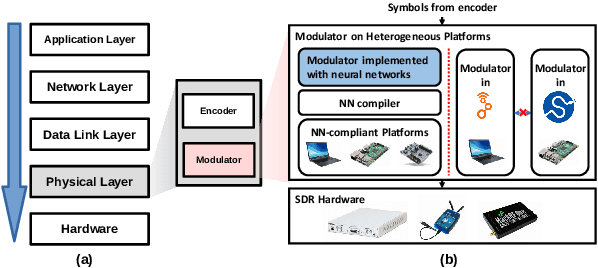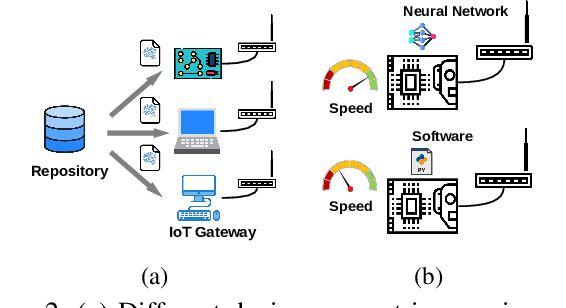Jiazhao Wang
Efficient and Distortion-less Spectrum Multiplexer via Neural Network-based Filter Banks
Jul 23, 2025Abstract:Spectrum multiplexer enables simultaneous transmission of multiple narrow-band IoT signals through gateway devices, thereby enhancing overall spectrum utilization. We propose a novel solution based on filter banks that offer increased efficiency and minimal distortion compared with conventional methods. We follow a model-driven approach to integrate the neural networks into the filter bank design by interpreting the neural network models as filter banks. The proposed NN-based filter banks can leverage advanced learning capabilities to achieve distortionless multiplexing and harness hardware acceleration for high efficiency. Then, we evaluate the performance of the spectrum multiplexer implemented by NN-based filter banks for various types of signals and environmental conditions. The results show that it can achieve a low distortion level down to $-39$dB normalized mean squared error. Furthermore, it achieves up to $35$ times execution efficiency gain and $10$dB SNR gain compared with the conventional methods. The field applications show that it can handle both the heterogeneous and homogeneous IoT networks, resulting in high packet reception ratio at the standard receivers up to $98\%$.
NNCTC: Physical Layer Cross-Technology Communication via Neural Networks
Mar 15, 2024



Abstract:Cross-technology communication(CTC) enables seamless interactions between diverse wireless technologies. Most existing work is based on reversing the transmission path to identify the appropriate payload to generate the waveform that the target devices can recognize. However, this method suffers from many limitations, including dependency on specific technologies and the necessity for intricate algorithms to mitigate distortion. In this work, we present NNCTC, a Neural-Network-based Cross-Technology Communication framework inspired by the adaptability of trainable neural models in wireless communications. By converting signal processing components within the CTC pipeline into neural models, the NNCTC is designed for end-to-end training without requiring labeled data. This enables the NNCTC system to autonomously derive the optimal CTC payload, which significantly eases the development complexity and showcases the scalability potential for various CTC links. Particularly, we construct a CTC system from Wi-Fi to ZigBee. The NNCTC system outperforms the well-recognized WEBee and WIDE design in error performance, achieving an average packet reception rate(PRR) of 92.3% and an average symbol error rate(SER) as low as 1.3%.
NN-Defined Modulator: Reconfigurable and Portable Software Modulator on IoT Gateways
Mar 14, 2024



Abstract:A physical-layer modulator is a vital component for an IoT gateway to map the symbols to signals. However, due to the soldered hardware chipsets on the gateway's motherboards or the diverse toolkits on different platforms for the software radio, the existing solutions either have limited extensibility or are platform-specific. Such limitation is hard to ignore when modulation schemes and hardware platforms have become extremely diverse. This paper presents a new paradigm of using neural networks as an abstraction layer for physical layer modulators in IoT gateway devices, referred to as NN-defined modulators. Our approach addresses the challenges of extensibility and portability for multiple technologies on various hardware platforms. The proposed NN-defined modulator uses a model-driven methodology rooted in solid mathematical foundations while having native support for hardware acceleration and portability to heterogeneous platforms. We conduct the evaluation of NN-defined modulators on different platforms, including Nvidia Jetson Nano and Raspberry Pi. Evaluations demonstrate that our NN-defined modulator effectively operates as conventional modulators and provides significant efficiency gains (up to $4.7\times$ on Nvidia Jetson Nano and $1.1\times$ on Raspberry Pi), indicating high portability. Furthermore, we show the real-world applications using our NN-defined modulators to generate ZigBee and WiFi packets, which are compliant with commodity TI CC2650 (ZigBee) and Intel AX201 (WiFi NIC), respectively.
Environment-independent mmWave Fall Detection with Interacting Multiple Model
Nov 15, 2023



Abstract:The ageing society brings attention to daily elderly care through sensing technologies. The future smart home is expected to enable in-home daily monitoring, such as fall detection, for seniors in a non-invasive, non-cooperative, and non-contact manner. The mmWave radar is a promising candidate technology for its privacy-preserving and non-contact manner. However, existing solutions suffer from low accuracy and robustness due to environment dependent features. In this paper, we present FADE (\underline{FA}ll \underline{DE}tection), a practical fall detection radar system with enhanced accuracy and robustness in real-world scenarios. The key enabler underlying FADE is an interacting multiple model (IMM) state estimator that can extract environment-independent features for highly accurate and instantaneous fall detection. Furthermore, we proposed a robust multiple-user tracking system to deal with noises from the environment and other human bodies. We deployed our algorithm on low computing power and low power consumption system-on-chip (SoC) composed of data front end, DSP, and ARM processor, and tested its performance in real-world. The experiment shows that the accuracy of fall detection is up to 95\%.
 Add to Chrome
Add to Chrome Add to Firefox
Add to Firefox Add to Edge
Add to Edge